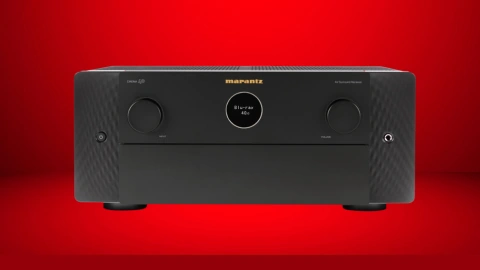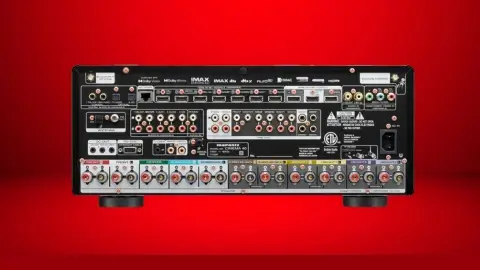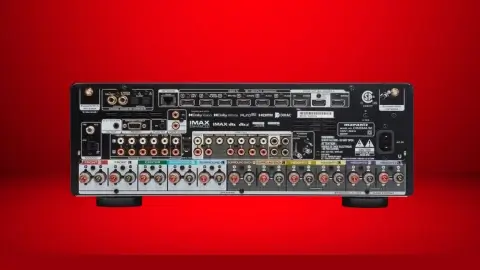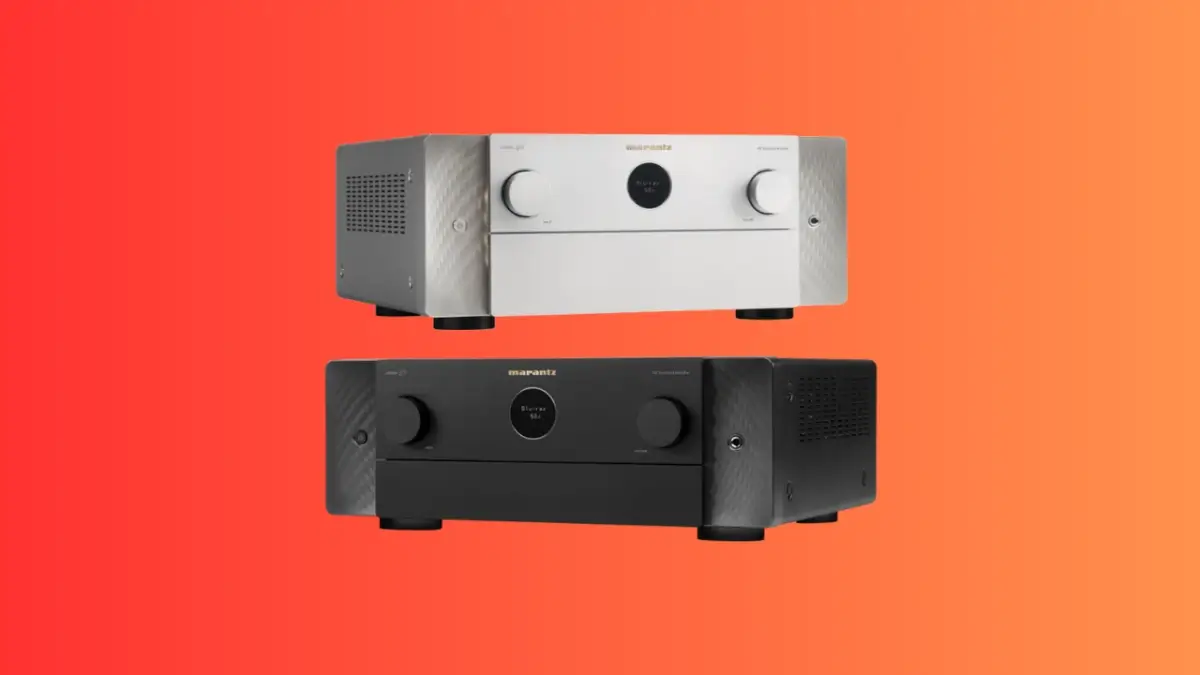After spending quality time with both the Marantz Cinema 40 and Cinema 50, we can draw detailed hands-on comparisons between these two impressive AV receivers. Although they share the Marantz pedigree and much of their specification list, there are differences to note.
Marantz Cinema 40 vs. Cinema 50 Specs at a Glance:
| Marantz Cinema 40 | Marantz Cinema 50 | |
|---|---|---|
 | 
| |
| Amplifier | 9.2 Channel (125W per channel) | 9.4 Channel (110W per channel) |
| Supported Music Files | MP3 / WMA / AAC | MP3 / WMA / AAC |
| Video | 8K/60Hz or 4K/120Hz pass-through, Dolby Vision, HDR10+, Dynamic HDR, HLG, HDR10, 3D | 8K/60Hz or 4K/120Hz pass-through, Dolby Vision, HDR10+, Dynamic HDR, HLG, HDR10, 3D |
| Audio Formats | MP3 / WMA / AAC, FLAC HD / WAV / ALAC / DSD | MP3 / WMA / AAC, FLAC HD / WAV / ALAC / DSD |
| Dimensions (W x D x H) | 17.3 x 16.2 x 7.3 | 17.4 x 15.4 x 6.5 |
| Weight | 33.3 lbs | 29.8 lbs |
| Price | Check on Amazon BHPhotoVideo.com | Check on Amazon BHPhotoVideo.com |
A Closer Look at Design

Upon unboxing the two receivers, we were met with the classic Marantz aesthetic that combines sophistication with a clean finish. The Cinema 50 leans more towards minimalism, with a streamlined porthole OLED front display, while the Cinema 40 provides more information with its 2-line FLD + porthole OLED. We spent time cycling through the displays and found both to be highly readable and user-friendly, although the Cinema 40 offers more upfront information. Don’t Miss Out! See Current Price on Amazon
We also noted that the Cinema 40 is available in both standard Black and an exclusive Silver-Gold, giving a tad more variety to those who care about their AV equipment fitting in with their interior design.

Powering Up and Testing Output
Power output is a key differentiator between the two models. When we connected identical speaker systems and played the same audio content, the difference was palpable. The Cinema 40 pushed out 125W at 8 ohms and 165W at 6 ohms, compared to the Cinema 50’s 110W at 8 ohms and 150W at 6 ohms. The subtle extra power from the Cinema 40 could be discerned in larger rooms, particularly when using power-hungry speakers.
Exploring Connectivity Options

Next, we put the receivers through their paces in terms of connectivity. The Cinema 40 stands out with one more HDMI input and an extra analog multi-room output, which can be particularly useful if you have a complex home theater setup with numerous source devices or if you plan to have audio in multiple rooms.
Moreover, we connected an 8K TV to test the HDMI output capabilities of the Cinema 40, which performed splendidly, suggesting it’s better suited for future-proofing your home theater. Read our full review of the Cinema 40.

Audio Processing Examination
The audio processing capabilities of the two receivers are on par with each other, with support for Dolby Atmos, DTS:X, and Auro-3D. In our detailed testing, using a variety of content from action-packed movies to intricate orchestral pieces, both models handled these technologies superbly, producing immersive and detailed soundscapes that impressed our team.
Evaluating Streaming Support
We delved into the world of streaming next. Both receivers support HEOS, AirPlay 2, and a variety of other services like Spotify Connect, Pandora, SiriusXM, and more. Streaming music on both units was a breeze, and they capably handled lossless formats like FLAC HD, WAV, ALAC, and DSD Audio, rendering excellent sound quality.
Multi-room Capabilities
In our multi-room tests, the Cinema 40 outperformed the Cinema 50 by supporting up to three zones, compared to the Cinema 50’s two. We set up music in multiple rooms and found the third zone a distinct advantage for larger homes or spaces with more complex audio needs.
Room Correction Features
We subjected both receivers to various room conditions, from echoing spaces to asymmetric layouts. Each time, the built-in Audyssey MultEQ XT32 room correction suite provided noticeable improvements, optimizing audio performance for the specific room characteristics. The process was smooth and user-friendly on both models.
Power Consumption
For the environmentally conscious, we noted that the Cinema 50 consumes slightly less power when idle, although this won’t make a significant difference to your energy bills.
User-Friendly Features
In the course of our testing, we put the receivers’ user-friendly features under scrutiny as well. The Cinema 40 and Cinema 50 both come with a well-designed, intuitive remote control, but the Cinema 40 also includes a second, simplified remote. This can be handy in scenarios where you want to hand off control to someone less familiar with the system.
Additionally, we examined the Marantz AVR remote app and found it to be easy to navigate on both models. The app allowed us to control the receiver’s primary functions conveniently from our smartphones, which is a nice touch for those who prefer app-based control.
Warranty and Support
Finally, no comparison would be complete without considering the warranty and support offered by the manufacturer. Both receivers come with a three-year warranty, indicating Marantz’s confidence in their products’ longevity. During our testing, we reached out to Marantz’s customer service for both models and were met with responsive and helpful assistance.
Pros & Cons of the Cinema 40 AV Receiver

Pros
- Superior audio processing and amplification capabilities.
- Comprehensive streaming and connectivity options.
- Room correction features for optimal audio experience.
- Support for multi-room audio setups.
- Includes an additional, simplified remote.
Cons
- Higher power consumption than the Cinema 50.
- May be overkill for simple audio setups.
Equipped with 9.2 channels, the Marantz Cinema 40 is a true technical tour de force. Offering a power output of 125W at 8 ohms and 165W at 6 ohms, it’s particularly effective in larger room settings. Not only does it serve as an extensive connectivity hub with an extra HDMI input and an additional analog multi-room output, but it also impresses with its 8K HDMI output capabilities, making it a future-proof choice.
It stands out in multi-room setups, comfortably supporting up to three zones. Despite consuming slightly more power, it excels in audio processing and streaming support. The inclusion of an extra, simplified remote adds to its user-friendly approach.
Pros & Cons of the Cinema 50 AV Receiver

Pros
- Strong audio processing and output performance.
- Wide range of streaming and connectivity features.
- Room correction technology for improved sound.
- More power-efficient than the Cinema 40.
- Slightly more affordable option.
Cons
- Lacks support for multi-room audio setups.
- Does not include an extra simplified remote.
Offering 9.4 channels, the Marantz Cinema 50 delivers solid technical performance. With a power output of 110W at 8 ohms and 150W at 6 ohms, it ensures strong audio output across various media. It features a broad spectrum of connectivity and streaming options, efficiently handling multiple source devices. Though it supports two zones for multi-room setups, it still covers the needs of most households effectively.
The Cinema 50 stands out for its power efficiency, consuming less power when idle compared to the Cinema 40, which appeals to the energy-conscious. Matching the Cinema 40 in terms of audio processing and streaming support, it assures a quality audio experience. Though it lacks an additional simplified remote, the primary remote control is intuitive and easy to navigate.
Conclusion
After this hands-on, in-depth comparison, it’s clear that the Cinema 40 offers a bit more in terms of power, connectivity, and multi-room capabilities. >>> Get the Best Deal on BHPhotoVideoToday!
However, the Cinema 50 holds its own with similar audio processing prowess, streaming support, and room correction features. The decision ultimately lies with individual needs and preferences.
For those planning to set up an extensive home theater system in larger spaces or intending to utilize multi-room audio features, the Cinema 40 offers added benefits.
On the other hand, if your setup is more straightforward or you’re looking for a slightly more power-efficient model, the Cinema 50 is a capable contender that delivers an impressive performance.
